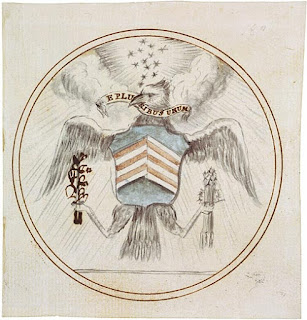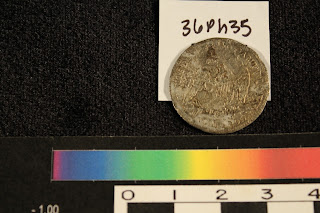President’s Day is approaching, and in honor of this
important national holiday, we will focus on examples an American symbol of
patriotism, the Great Seal of the United States, that have been found at
archaeological sites.
Created originally to honor George Washington’s birthday, we
now recognize all of our nation’s leaders on this day which will be Monday,
February 15th. Pennsylvania
has always played an important role in the development of our nation and those
of you who follow our blog have read of our involvement in the French &
Indian War and the Revolutionary War.
The signing of the Declaration of Independence in Philadelphia in 1776
was viewed as a “united” declaration of freedom from British rule and a first
in coming together for the original 13 colonies. It took an additional six
years and three committees for the nation to agree on the design of the Great
Seal.
The key component of the seal is the eagle. The eagle has symbolized strength and power
for thousands of years, dating back to Greek mythology and biblical
references. The use of the American bald
eagle identified it as uniquely our own.
On its breast is a shield marked with thirteen vertical red and white
stripes topped by a bar of blue. The original design was created by Charles
Thomson, an immigrant to Pennsylvania from Ireland who later served as
Secretary of the Continental Congress. Thomson was an important political
figure and a strong proponent for independence from British rule. His design combined elements from the
previous committees into one for which Thomson is credited.
The elements chosen for this iconic design were carefully
selected and have stood the test of time. The shield represents the uniting of
the thirteen colonies under one government- Congress. At the time we had not
created the office of President. The eagle holds arrows in the right claw and
an olive branch in the left claw. These
are to symbolize Congresses power to make peace (olive branch) and war
(arrows). The thirteen stars above the eagle are representing the new colonies
and those that would come later. The
banner holds the Latin phrase, E pluribus
unum – “From Many, One”. The message
was clear among these members of Congress that we needed to unite as one entity,
one nation.
image-source- http://www.ourdocuments.gov/doc.php?flash=true&doc=5
It comes as no surprise that this powerful symbol would soon
appear on ceramics, bottles and military buttons. It would later be incorporated into the
Presidential Seal and our nation’s currency.
Archaeological excavations in the Philadelphia area have recovered
several examples of our Great Seal, likely an indicator of the significant role
Pennsylvania played in the founding of our nation and the incorporation this
important symbol into our society.
An archaeological investigation was conducted by Louis Berger
& Associates in the late 1980’s for proposed ramp construction of I-95 in
the area south of Penn’s Landing in Philadelphia’s historic waterfront district.
This site provided an opportunity for archaeologists to examine early
consumerism, and colonial trade patterns. Identified as The Meadows Project, this investigation preserved the personal
effects of tenants in an early working class neighborhood. Datable ceramics
indicate that most of the artifacts recovered could be traced to the period
from 1800 to 1870, although households would often contain “heirloom” ceramics.
An investigation conducted prior to the construction of the
Metropolitan Detention Center provided yet another opportunity for
archaeologists to examine a number of cisterns associated with wealthier Quaker
families. The preservation of wells,
cisterns and privies under a paved parking lot in urban Philadelphia was one of
the earliest examples of these preserved resources in an otherwise developed
city. [Recent investigations for the I-95 expansion (http://diggingi95.com/ ) have further
demonstrated these preserved landscapes and are providing a wealth of
information for archaeologists recreating the cultural heritage of
Philadelphia.]
Archaeologists recovered several other examples of ceramics
with the Great Seal symbol, an indicator of its popularity and
significance. There are some slight
variations to these depictions of the seal, but the basic symbolism of
patriotism continues. The addition of a
phrase- “Present for my Dear Boy” to the symbol provides an interesting
reflection on its use to perhaps inspire civic awareness or patriotism.
However you choose to reflect upon our Presidents, past and
present, we can look to our archaeological heritage and the preservation of
these symbols of patriotism and take pride in Pennsylvania’s role in the founding
these United States of America- From
Many, One.








Wow, this is really interesting!
ReplyDeletehttps://www.bloglovin.com/blogs/philly-with-a-fjallraven-14621583